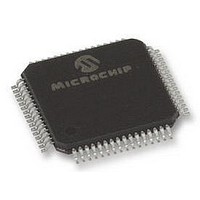DSPIC30F5011-30I/PTG Microchip Technology, DSPIC30F5011-30I/PTG Datasheet - Page 44

DSPIC30F5011-30I/PTG
Manufacturer Part Number
DSPIC30F5011-30I/PTG
Description
16BIT MCU-DSP 30MHZ, SMD, 30F5011
Manufacturer
Microchip Technology
Series
DsPIC30Fr
Datasheet
1.DSPIC30F5011-30IPTG.pdf
(220 pages)
Specifications of DSPIC30F5011-30I/PTG
Core Frequency
30MHz
Embedded Interface Type
CAN, I2C, SPI, UART
No. Of I/o's
52
Flash Memory Size
66KB
Supply Voltage Range
2.5V To 5.5V
Operating Temperature Range
-40°C To
Lead Free Status / RoHS Status
Lead free / RoHS Compliant
- Current page: 44 of 220
- Download datasheet (4Mb)
dsPIC30F5011/5013
Address Error Trap:
This trap is initiated when any of the following
circumstances occurs:
1.
2.
3.
4.
5.
6.
Stack Error Trap:
This trap is initiated under the following conditions:
1.
2.
Oscillator Fail Trap:
This trap is initiated if the external oscillator fails and
operation becomes reliant on an internal RC backup.
DS70116C-page 42
Note:
A misaligned data word access is attempted.
A data fetch from our unimplemented data
memory location is attempted.
A data access of an unimplemented program
memory location is attempted.
An instruction fetch from vector space is
attempted.
Execution of a “BRA #literal” instruction or a
“GOTO #literal” instruction, where literal
is an unimplemented program memory address.
Executing instructions after modifying the PC to
point to unimplemented program memory
addresses. The PC may be modified by loading
a value into the stack and executing a RETURN
instruction.
The stack pointer is loaded with a value which is
greater than the (user programmable) limit value
written into the SPLIM register (stack overflow).
The stack pointer is loaded with a value which is
less than 0x0800 (simple stack underflow).
In the MAC class of instructions, wherein
the data space is split into X and Y data
space, unimplemented X space includes
all of Y space, and unimplemented Y
space includes all of X space.
Preliminary
5.3.2
It is possible that multiple traps can become active
within the same cycle (e.g., a misaligned word stack
write to an overflowed address). In such a case, the
fixed priority shown in Figure 5-2 is implemented,
which may require the user to check if other traps are
pending, in order to completely correct the fault.
‘Soft’ traps include exceptions of priority level 8 through
level 11, inclusive. The arithmetic error trap (level 11)
falls into this category of traps.
‘Hard’ traps include exceptions of priority level 12
through level 15, inclusive. The address error (level
12), stack error (level 13) and oscillator error (level 14)
traps fall into this category.
Each hard trap that occurs must be acknowledged
before code execution of any type may continue. If a
lower priority hard trap occurs while a higher priority
trap is pending, acknowledged, or is being processed,
a hard trap conflict will occur.
The device is automatically Reset in a hard trap conflict
condition. The TRAPR status bit (RCON<15>) is set
when the Reset occurs, so that the condition may be
detected in software.
FIGURE 5-1:
AIVT
IVT
HARD AND SOFT TRAPS
Address Error Trap Vector
Address Error Trap Vector
Oscillator Fail Trap Vector
Oscillator Fail Trap Vector
Reset - GOTO Instruction
Stack Error Trap Vector
Stack Error Trap Vector
Math Error Trap Vector
Math Error Trap Vector
Reset - GOTO Address
Interrupt 52 Vector
Interrupt 52 Vector
Interrupt 53 Vector
Interrupt 53 Vector
Interrupt 0 Vector
Interrupt 1 Vector
Interrupt 0 Vector
Interrupt 1 Vector
Reserved Vector
Reserved Vector
Reserved Vector
Reserved Vector
Reserved Vector
Reserved Vector
TRAP VECTORS
2004 Microchip Technology Inc.
Reserved
Reserved
Reserved
Reserved
—
—
—
—
—
—
0x000000
0x000014
0x000094
0x0000FE
0x000002
0x000004
0x00007E
0x000082
0x000084
0x000080
Related parts for DSPIC30F5011-30I/PTG
Image
Part Number
Description
Manufacturer
Datasheet
Request
R

Part Number:
Description:
IC DSPIC MCU/DSP 66K 64TQFP
Manufacturer:
Microchip Technology
Datasheet:

Part Number:
Description:
IC,DSP,16-BIT,CMOS,TQFP,64PIN,PLASTIC
Manufacturer:
Microchip Technology
Datasheet:

Part Number:
Description:
IC DSPIC MCU/DSP 66K 64TQFP
Manufacturer:
Microchip Technology
Datasheet:

Part Number:
Description:
High-Performance Digital Signal Controllers
Manufacturer:
MICROCHIP [Microchip Technology]
Datasheet:

Part Number:
Description:
IC, DSC, 16BIT, 66KB, 40MHZ 5.5V TQFP-64
Manufacturer:
Microchip Technology
Datasheet:

Part Number:
Description:
Digital Signal Processors & Controllers - DSP, DSC 16 Bit MCU/DSP 64LD 20M 66KB FL
Manufacturer:
Microchip Technology

Part Number:
Description:
IC DSPIC MCU/DSP 66K 64TQFP
Manufacturer:
Microchip Technology
Datasheet:

Part Number:
Description:
Dspic30f5011/5013 High-performance Digital Signal Controllers
Manufacturer:
Microchip Technology Inc.
Datasheet:

Part Number:
Description:
Manufacturer:
Microchip Technology Inc.
Datasheet:

Part Number:
Description:
Manufacturer:
Microchip Technology Inc.
Datasheet:

Part Number:
Description:
Manufacturer:
Microchip Technology Inc.
Datasheet:

Part Number:
Description:
Manufacturer:
Microchip Technology Inc.
Datasheet:










